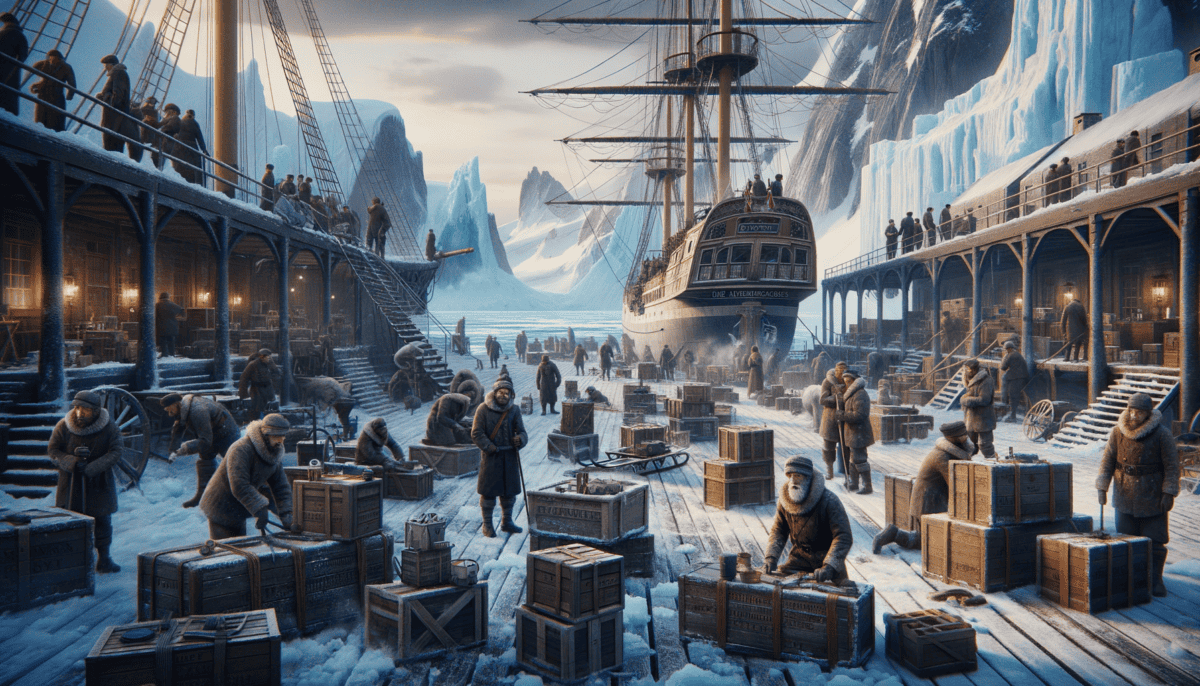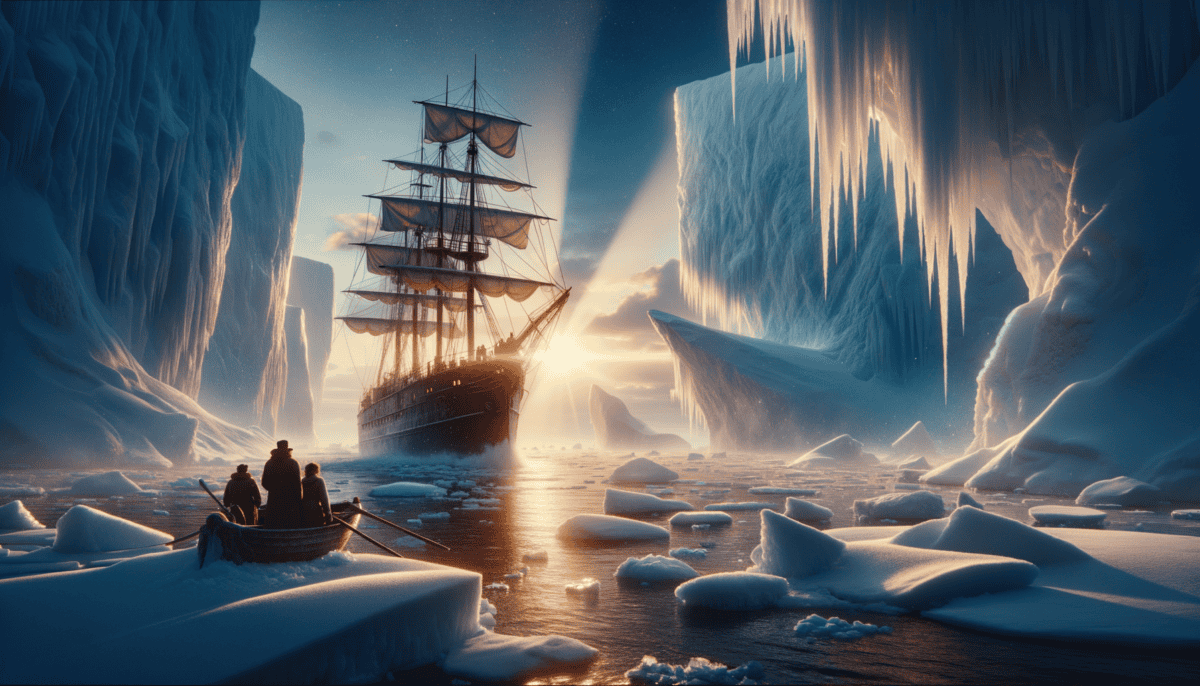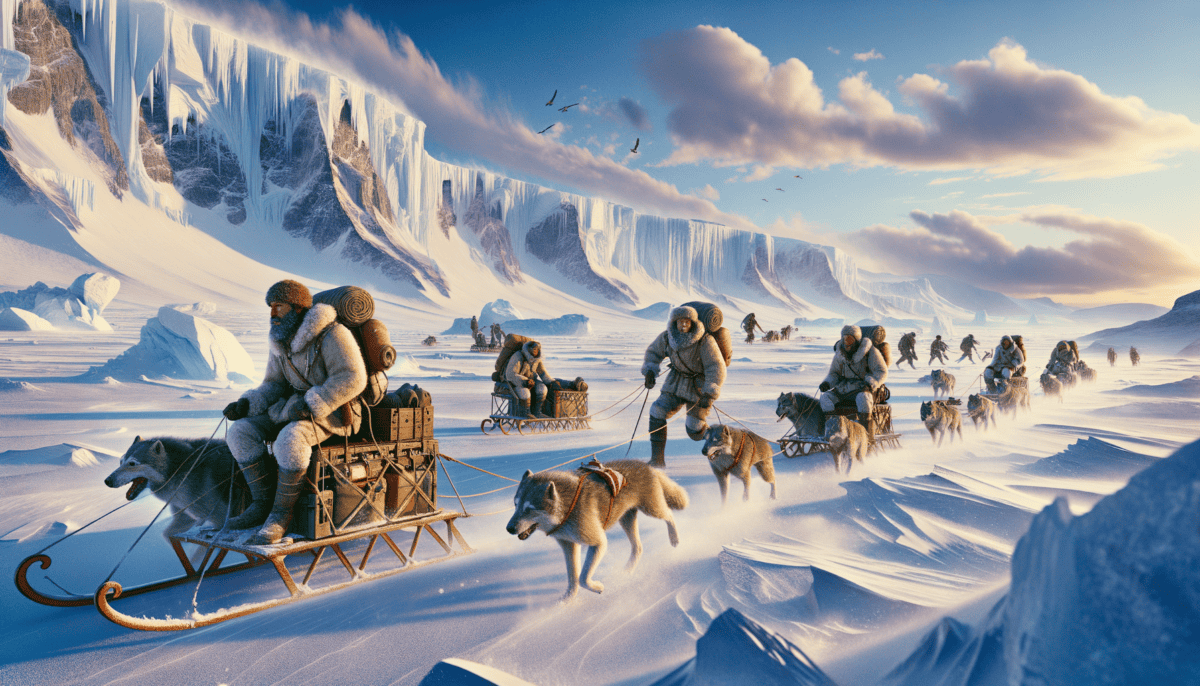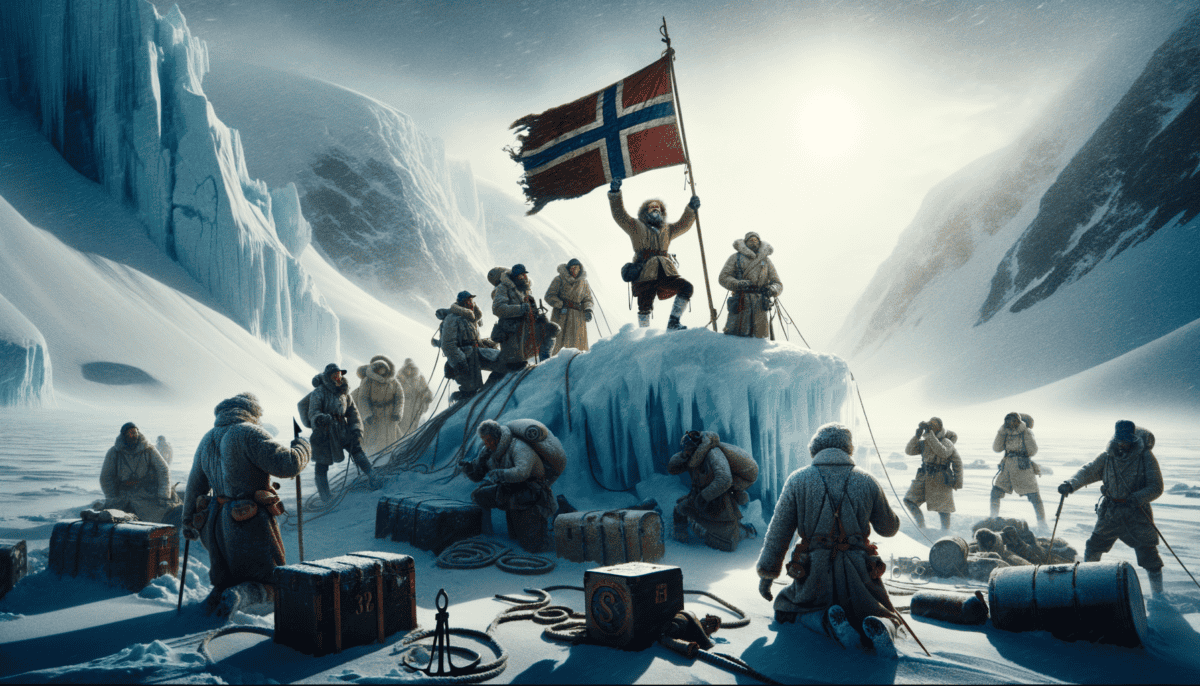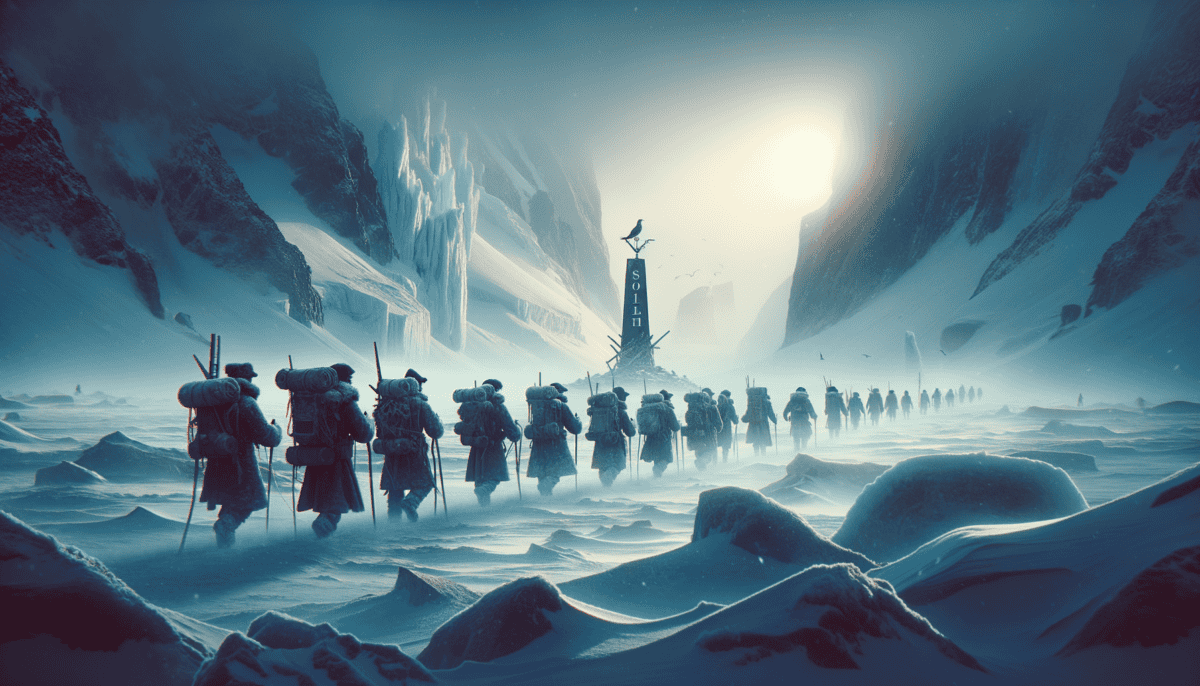Dreams of Discovery
The cold wind howled across the frozen landscape as two men, worlds apart, dreamed of the same icy prize. ❄️ The South Pole was calling their names.
"Mother, one day I will be the first to reach the South Pole!" young Roald Amundsen declared, his blue eyes sparkling with determination. Growing up in Norway, where snow was as common as sunshine, Roald loved the cold. He would spend hours reading stories about brave explorers who ventured into frozen lands.
Meanwhile, across the sea in England, Robert Falcon Scott was having similar dreams. As a navy officer, he stood tall and proud on his ship's deck, imagining the adventures that awaited him in the mysterious Antarctic.
“The ice calls to those brave enough to answer,” Scott wrote in his diary. “And I must answer that call.”
In the late 1800s, the South Pole was one of Earth's last great mysteries. No one had ever reached it! It was a place where temperatures dropped lower than anywhere else on Earth, and the sun didn't shine for months at a time.
"Why do you want to go there?" people would ask both men.
Roald would smile and say, "Because it has never been done before!"
The race to the South Pole wasn't just about two men – it was about two countries. Norway and Britain both wanted to be first to plant their flag in the ice. It was like a giant game of capture the flag, but the prize was one of the most extreme places on Earth!
Roald trained by sleeping with his windows open in freezing weather. He learned to ski before he could walk, and he studied how the Inuit people survived in cold places. He was like a student preparing for the biggest test of his life!
Scott prepared differently. He believed in the power of new machines and scientific equipment. "Technology will help us conquer the pole," he told his team. He spent hours studying maps and weather patterns.
The year was 1910, and both men were ready to begin their great adventure. Their ships were packed with supplies, their teams were chosen, and their hearts were full of hope. But the frozen continent had other plans for them…
As they prepared to leave, newspapers around the world printed exciting headlines:
“WHO WILL REACH THE SOUTH POLE FIRST?”
Little did they know that this race would become one of the greatest adventure stories ever told. Each man faced challenges that would test not just their bodies, but their very souls.
The great white continent waited silently, its icy winds whispering secrets that only the bravest would discover. For Roald Amundsen and Robert Falcon Scott, their dreams of discovery were about to become very real – and very dangerous.
"Remember," Roald told his crew as they loaded their ship, "we're not just explorers. We're dreamers making our dreams come true." His words echoed across the dock, carrying the weight of history yet to be made.
Scott stood on his own ship, looking south toward the unknown. "Gentlemen," he announced to his team, "we sail not just for ourselves, but for all of Britain. The pole awaits."
And so began the greatest race in exploration history, as two brave men chased their childhood dreams across the bottom of the world. Their story was just beginning, but Antarctica was ready with challenges that would test every ounce of their courage and determination.
A Tale of Two Teams
The docks buzzed with excitement as Roald Amundsen loaded his ship, the Fram. Dogs barked and sailors shouted as they packed boxes of food, warm clothes, and special tools for the ice.
“These dogs will be our secret weapon,” Roald said, patting a husky’s furry head. He had chosen 97 strong dogs to pull their sleds across the ice. Each dog was special – they were used to cold weather and could run for hours.
“In the snow, dogs are better than machines,” Roald told his team. “They know the ice, and they never break down.”
Meanwhile, Robert Scott was doing things very differently. His ship, the Terra Nova, was filled with motor sleds and ponies.
• Amundsen: Used dogs and skis
• Scott: Used ponies and motor sleds
• Amundsen: Lighter clothes in layers
• Scott: Heavy fur clothes
• Amundsen: Simple foods
• Scott: Fancy canned foods
Both leaders carefully picked their team members. Roald chose people who were great at skiing and knew how to work with dogs. Scott picked scientists and navy men who were brave and strong.
“We must work together like a family,” Roald told his men. They practiced skiing every day and learned how to care for the dogs. They even ate the same food they would eat on their journey to make sure they liked it.
Scott’s team practiced too, but they spent more time checking their machines and studying science. “We’re not just trying to reach the pole,” Scott said. “We want to learn about Antarctica too!”
Getting ready cost lots of money. Roald sold everything he owned to buy supplies. Scott got help from his country and rich people who wanted Britain to win.
“The cold will be our biggest enemy,” Roald warned as they packed warm clothes. His team wore thin layers they could take off when they got hot from moving. Scott’s team chose thick, heavy fur coats.
As the days grew closer to leaving, both teams checked their maps. ️ Antarctica was huge – bigger than the United States! Finding the South Pole would be like finding a tiny dot in a giant white blanket.
The night before they left, Roald wrote in his diary: “Tomorrow we sail south. Our dogs are strong, our skis are ready, and our hearts are brave.”
Scott looked at his motor sleds with pride. “With these machines,” he said, “we’ll make history for Britain!”
Little did they know that each choice they made – from their clothes to their food to how they would travel – would make a big difference in who would reach the pole first.
The ships were ready. The teams were ready. The race to the bottom of the world was about to begin, and only time would tell whose plan would work better in the coldest place on Earth. ️
Into the Frozen Unknown
The waves crashed against the ships as they sailed south. ⛵ The air got colder each day, and soon tiny ice pieces floated in the dark water like swimming diamonds.
“Look!” shouted Lars, one of Amundsen’s men, pointing at something big and white ahead. “Our first iceberg!” The team rushed to the side of the Fram to see the giant ice mountain floating in the sea.
“Remember, boys,” Amundsen called out with a smile, “where there’s ice, there’s a way!”
On Scott’s ship Terra Nova, things weren’t going as smoothly. The heavy waves made the ponies scared and sick. Many of the motor sleds got wet from the sea spray, making the team worried they might rust.
• Big waves made travel hard
• Animals got seasick
• Very cold winds
• Ice blocked the way
• Fog made it hard to see
Both ships had to be very careful sailing through the ice. Sometimes they got stuck and had to wait for the ice to move. The crews played cards and told stories to pass the time. ♠️
One stormy night, Amundsen gathered his team in the warm cabin. “Tomorrow we’ll see Antarctica,” he said. “It will be the whitest, coldest place you’ve ever seen. But we’re ready!”
The next morning, they saw it – Antarctica! The white continent stretched as far as they could see. Tall ice cliffs rose from the water like frozen giants. ❄️
“It’s beautiful,” whispered Tom, one of Scott’s men, as the Terra Nova approached the ice shelf. “But it looks so… empty.”
The teams started unloading their supplies onto the ice. Amundsen’s dogs were excited to run around after being on the ship so long. They jumped and played in the snow, their tails wagging with joy.
Scott’s team had trouble with their motor sleds. The cold made them hard to start, and the snow was deeper than they expected. “Keep trying,” Scott encouraged his men. “We’ll figure it out!”
Both teams built their first camps on the ice. They put up strong tents that could stand up to the wild Antarctic winds. Inside, they had warm sleeping bags and small stoves for cooking.
“The real journey starts now,” Amundsen told his team as they sat in their tent drinking hot cocoa. “Tomorrow we start skiing south!” ⛷️
That night, the sound of howling wind kept many awake. In his tent, Scott wrote in his diary: “This place is more challenging than we imagined. But we must keep going. For Britain!”
As both teams tried to sleep, the Antarctic night sky danced with beautiful lights called the Southern Lights. It was like nature’s way of welcoming them to the bottom of the world.
The next morning would bring new challenges, but for now, they had made it to Antarctica. The great race to the South Pole was truly beginning, and no one knew what adventures waited ahead in this frozen land.
Into the Heart of Antarctica
The morning sun glowed on the endless white landscape. Both teams were now deep in Antarctica’s frozen heart, where the air was so cold it made their breath turn to tiny ice crystals.
“The dogs are doing great!” said Olav, patting his favorite husky’s head. “They love this weather!”
Amundsen’s team moved smoothly across the snow. Their skis made soft swishing sounds, and the dogs pulled the sleds with strong, steady steps. The Norwegian team had learned to work as one with their furry helpers.
Meanwhile, Scott’s team was having a harder time. Without dogs, they had to pull their heavy sleds themselves. “Push harder, men!” Scott called out as they struggled up a snowy hill. “Every step takes us closer to our goal!” ️
The weather turned nasty that afternoon. Wind howled like angry wolves, and snow flew everywhere. Amundsen checked his compass and frowned. “We need to make camp,” he decided. “This storm is too dangerous.”
Survival in the Storm
Inside their tent, Scott’s team huddled together for warmth. Evans, one of the strongest men, was shivering. “I’ve never felt cold like this,” he whispered. The temperature had dropped to -40 degrees! ❄️
• Wear lots of layers
• Keep moving
• Eat fatty foods
• Drink hot drinks
• Sleep close together
Amundsen’s team was better prepared for the cold. They wore loose fur clothes like the Inuit people taught them. “See?” Amundsen smiled, showing how the fur kept the snow from sticking. “Nature knows best!”
The next day brought new challenges. Huge cracks in the ice, called crevasses, appeared in front of them. “Be careful!” shouted Scott as one of his men nearly slipped into a deep crack. “These crevasses can be deeper than ten houses stacked on top of each other!”
The dogs helped Amundsen’s team find safe paths. Their animal instincts could sense dangerous ice. “Good boy, Spot,” praised Bjaaland as his lead dog stopped before a hidden crack.
Both teams were getting tired. They had been walking for weeks now, and the South Pole still seemed so far away. At night, they dreamed of warm homes and soft beds.
“Look at those mountains!” gasped Wilson, pointing at huge peaks ahead. The teams had reached the Transantarctic Mountains, which they would have to cross to reach the South Pole. ️
Scott pulled out his map and sighed. “The hardest part is still ahead. We must climb these mountains while pulling our heavy sleds.”
That evening, as the sun circled low in the sky (remember, it never sets during Antarctic summer! ☀️), both teams rested and prepared for the big climb ahead. The mountains looked like giant ice cream cones touching the sky, and somewhere beyond them lay their goal – the South Pole.
In his tent, Amundsen marked their progress on his map. They were making good time, but the mountains would test them all. The race was far from over, and the frozen continent had many more surprises waiting for them.
Victory and Heartbreak
The morning of December 14, 1911, dawned clear and cold. Roald Amundsen squinted at his compass and smiled. “We’re almost there, boys!” His dogs wagged their tails, sensing the excitement in his voice. ️
“After all these months of ice and snow, we’re finally going to reach the South Pole!” Olav’s eyes sparkled with joy.
The Norwegian team glided forward on their skis. The dogs pulled strongly, their breath making little clouds in the freezing air. At exactly 3:00 PM, they stopped. Amundsen checked his instruments carefully.
“We made it!” cheered Bjaaland, jumping up and down. The men hugged each other, their eyes filled with happy tears that froze on their cheeks. They planted a Norwegian flag in the snow, its bright colors standing out against the white landscape.
The Other Side of Victory
More than a month later, on January 17, 1912, Robert Scott’s team trudged through the snow. They were tired and cold, but hope kept them going. Then Scott saw something that made his heart sink – a black flag fluttering in the distance.
“No… it can’t be,” Scott whispered, but it was true. They found Amundsen’s tent, Norwegian flag, and a letter. They had come in second place.
Wilson put his hand on Scott’s shoulder. “We still made it to the Pole, Captain. That’s something to be proud of.” But everyone could see the sadness in Scott’s eyes.
The British team took pictures at the Pole and collected samples for science. They couldn’t celebrate like the Norwegians had – their hearts were too heavy with disappointment.
Back in Norway, Amundsen’s team was welcomed as heroes. Children waved flags in the streets, and everyone wanted to hear stories about their amazing journey.
The Price of Glory
“Our dogs got us here,” Amundsen told reporters. “Without them, we couldn’t have won.” He gave each of his furry friends extra treats that night.
Meanwhile, Scott’s team faced a dangerous journey home. The weather turned worse than ever. Wind howled like a thousand angry bears, and the temperature dropped lower than anyone could imagine. ❄️
“Keep moving, men,” Scott encouraged his team. “We must get back to tell our story.”
In their sleeping bags at night, both teams thought about what they had achieved. Amundsen’s men dreamed of the celebrations waiting at home. Scott’s team hoped for enough strength to make the long journey back.
The race to the South Pole showed how brave explorers could be. Amundsen won by learning from the Inuit and trusting his dogs. Scott’s team showed great courage, even though things didn’t go as they hoped.
As the Antarctic night fell, the South Pole stood silent again. The flags and footprints would soon be covered by snow, but the story of these brave explorers would be remembered forever.
A Legacy of Courage
The icy winds whispered stories of bravery as spring arrived in Antarctica. While Amundsen’s team celebrated their safe return home, worry grew about Scott’s expedition. No one had heard from them in months.
“They should have been back by now,” whispered the worried people at the base camp.
When search parties finally found Scott’s tent buried in snow, they discovered the sad truth. Scott and his brave friends hadn’t made it home. They had faced the worst storm anyone had ever seen. ❄️
Remembering the Brave
News of Scott’s journey touched hearts around the world. People everywhere told stories about his team’s courage. In London, they built a beautiful statue to remember them.
Back in Norway, Amundsen felt sad when he heard about Scott. “They were brave men,” he said softly. “They loved exploring just as much as we did.”
The most important things we learned from these explorers were:
• Being brave and never giving up
• Working together as a team
• Learning from others who know more
• Planning carefully for big adventures
• Respecting nature's power
Antarctic Adventures Today
Now, scientists live and work at the South Pole all year round! They stay in a special station built right on the ice.
“We use special tools to study the stars and learn about Earth’s climate,” explains Sarah, a modern Antarctic scientist. “But we never forget the brave explorers who came first.”
Kids from all over the world learn about Amundsen and Scott in school. Their story teaches us that sometimes winning isn’t everything – it’s how brave you are that matters most.
The Antarctic ice still holds many secrets. Modern explorers use computers and satellites to help them study this amazing place. But they still need the same courage that Amundsen and Scott showed long ago. ️
A Continuing Story
“Look after our planet’s special places,” Amundsen once said. Today, people work hard to protect Antarctica’s ice, penguins, and seals.
Young explorers dream of visiting the South Pole, just like Amundsen and Scott did. They know it’s not just about being first – it’s about learning, discovering, and taking care of our Earth.
As the Antarctic snow falls softly on the memorial crosses marking Scott’s journey, new scientists arrive at the South Pole station. They carry on the spirit of discovery that began with those first brave steps on the ice so many years ago. ✨
The story of the South Pole reminds us that every person can be brave, work hard, and do amazing things. Sometimes we win, sometimes we face hard times, but what matters most is never giving up on our dreams.


